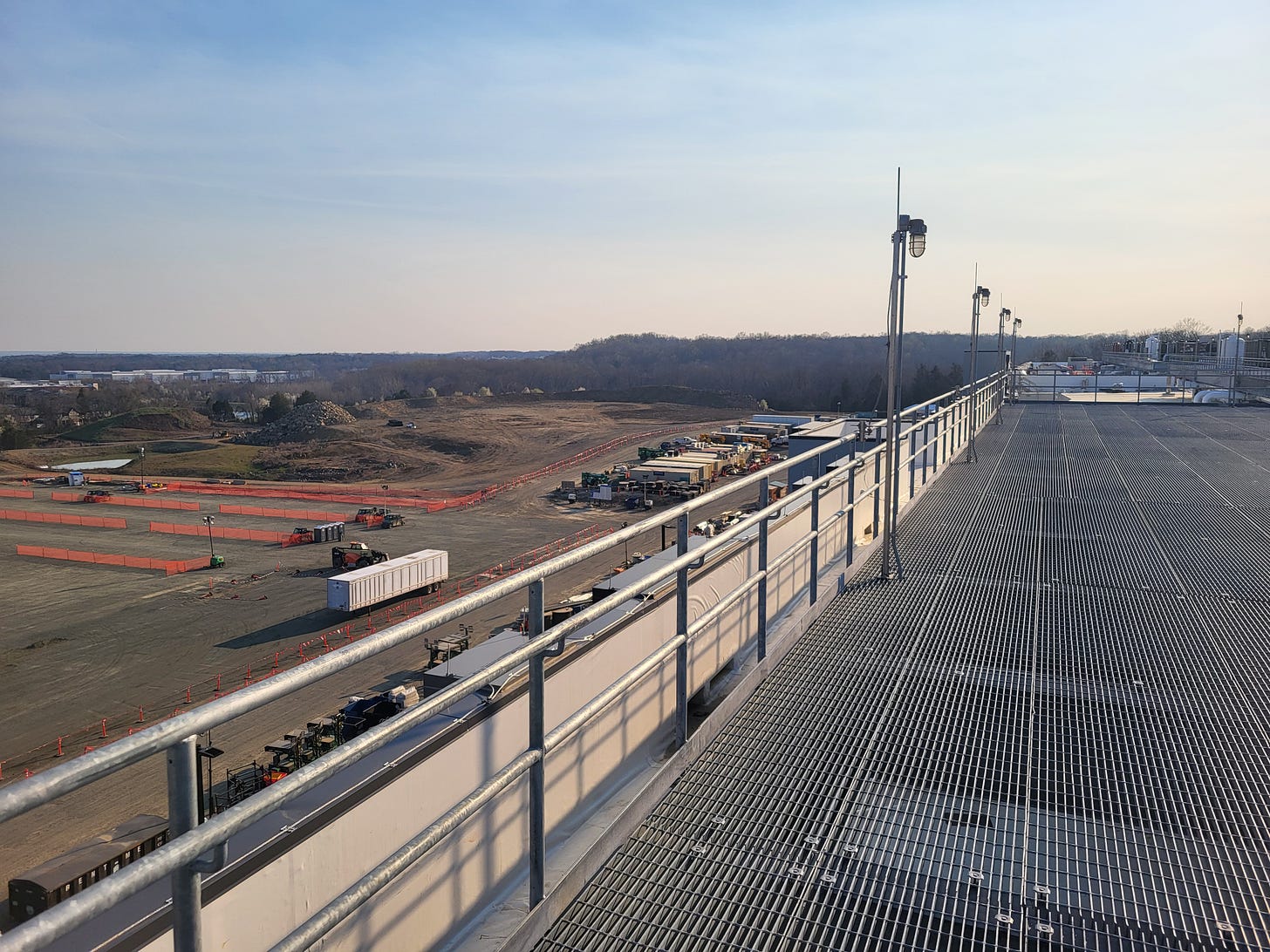
FXBG Advance recently visited two centers in Prince William County, seeing first-hand the size, potential, issues, and benefits these centers bring.
by Martin Davis
EDITOR-IN-CHIEF
Data centers are both hailed as regions’ financial saviors, and spurned for their impact on local environments as well as their ever-growing real-estate footprints.
Perhaps more than any other industry, however, they also sit at the nexus of what may prove to be a revolution not unsimilar to the First Agricultural Revolution 5,000 years ago, the invention of the printing press in the 15th century, and the development of the personal computer in the 1990s.
Though the first data center in Virginia was built 25 years ago, and there are more than 200 across the state, there’s still an air of mystery surrounding these facilities. In part because while these large buildings are easy to see from the road, they’re difficult to access due to the sensitive materials and data that flow through them.
The FXBG Advance was recently taken to two data centers in Prince William County, and we toured one of the sites. As Caroline, Louisa, Spotsylvania, and Stafford Counties begin to prepare for the arrival of multiple sites in their counties, we offer our readers a first-hand look at what these centers are, and what they are not.
Large, Quiet, and Learning from Past Mistakes
Even from beyond the iron fence with its control-access gate that ensures only authorized individuals are able to come onto the data center’s grounds, there’s no masking the fact that the 500,000 square-foot site we toured is a massive building.
To give some perspective to that number, were that total footage built on just one level, it would require more than 11 acres of land.

Beyond the size, however, one is also struck by the quiet.
Early on in Prince William County, noise from data centers was listed as one of the concerns with their development.
No high level of noise is to be heard, however, from the centers we visited, including the one that abuts a community that sparked the noise controversy in Prince William. In fact, less than a mile from the center we visited was the Black Sheep Restaurant. In addition to indoor dining, there’s a small outdoor concert venue, play area for children, and a dependable number of food trucks.
From that site, there is no noise to be heard.
Standing next to, and on top of the data centers themselves, there’s no noise to be heard, either.
In Prince William County, where data center development continues to be robust, the debates have shifted from noise to destruction of rural character. The county’s recent decision to approve a “Data Gateway” project has drawn the ire of rural residents and lawsuits.
That same concern is what ultimately led King George County to pull out of the agreement with Caroline, Louisa, Spotsylvania, and Stafford counties that is bringing Amazon Web Services—and tens of billions of dollars in new revenue.
The negotiated deals with the four counties primed to build new data centers, however, offer an abundant amount of open space between the data centers and the surrounding area. It’s one of the lessons learned from Prince William.
The buffers should go a long way toward ensuring that these facilities are largely out of the line of sight of most residents.
Concerns over preserving the county’s rural character factored into King George’s decision to pull out of a decision that had been signed in December and would have brought a data center to the county. That proposed facility, which is now off-the-table due to the Board of Supervisors’ decision in January, would have been built on more than 800 acres, 40% of which would have been open space or preservation area.
The county now wants to “reconsider” approval of the agreement that had been signed in December and would have brought a data center to the county.
Further distancing the public from the facilities would have been a minimum setback from roads of 150 feet.
In the four counties that are moving forward with AWS, the plans for their facilities include similar protections so that—unlike in Prince William—data centers don’t dominate the landscape.
Redundancy, and Power
Redundancy is central to the success of any data center. These facilities must run 24 hours a day, seven days a week, without fail. It’s more than a matter of convenience.
Whether we are aware, a significant portion of our lives flows daily through these data centers.
From computers and smartphones, which would not function today as we know them without data centers, to e-commerce, e-mail, smart utilities, online gaming, and on-demand entertainment—most anything that we touch depends on data centers operating efficiently.
For this reason, substantial reserve power must be on-hand. And at the facility we visited, that power was delivered by diesel fuel. Apart from testing the generators monthly, however, these machines rarely come on.
In fact, the generators are limited to 500 hours running time per year. At the facility we visited, the generators had run for less than 27 hours total since opening more than one year ago.

Backup power is not the only concern with data centers, however. The point is rightly made that data centers are placing an enormous strain on our electric grids.
At the center of this is Dominion, which is the company that is going to bear the brunt of data centers’ energy needs. Current energy use by data centers in Virginia stands at 2.67 gigawatts. That’s expected to grow to 10 gigawatts by 2028, owing both to the new data centers coming online in the state, as well as emerging Artificial Intelligence technologies which are driving this growth.
Meeting this will require significantly more high-power transmission lines, and more energy production, principally in the form of natural gas generation.
While such expansion is worrying, it’s one piece of a larger energy question. Data centers are not the only ones stressing the energy industry.
The automotive industry is doing the same. Electric cars will also stress the energy grid as they begin to become more-popular options with consumers. According to Consumer Reports, while the grid can currently handle the load, that will change over time.
If every car and truck in the U.S. were to convert to electric today, we’d need to produce 22% more energy than we currently do.
This does not minimize the challenge that data centers create. Rather, it recognizes that the country is undergoing an enormous shift in the way we think about how our economy functions, and how much energy will be required to run it.
The Payoff
Virginia is the data center capital of the world, and the world is going to need a lot more data centers in the future.
Building more of these centers outside of Loudoun and Prince William counties is one way to help Virginia retain its leading position in this market. It also spreads the wealth that these centers generate.
Data center tax revenue for locales is generated in two ways: from real property, which includes the land and the buildings, and from computer equipment. While real estate taxes are a known commodity, the tax revenues generated by computer equipment will fluctuate based on that equipment’s depreciation.
The latter of those two income streams has generated concerns that counties depending on data center money can be caught short-handed should depreciation lower tax revenues more than expected.
However, Buddy Rizer feels those concerns are misplaced.
“We haven’t had a shortfall in a decade,” says the Loudoun Economic Development Executive Director. “This year, we’re getting a billion dollars in [data center] tax revenues and have a $200 million surplus in our county budget.”
In 2020, however, the county did miscalculate the revenues the centers would produce. As reported in Loudoun Times:
In August 2020, the county overestimated the amount of revenue that would come from taxes on data center computer equipment, [leading] to a lower fund balance remaining at the end of fiscal 2021 — the county still took in more in revenue than budgeted.
Data centers refresh their equipment every three to five years, according to Rizer. “Every time they refresh, you start the cycle all over again.”
During COVID, however, the centers weren’t able to replace their equipment as planned, which accounted for the miscalculation.
That blip has led the county to create a “stabilization fund” in the event of a similar blip.

One reason for the steady fiscal growth is the rapid expansion of data centers in the county. According to Rizer, data center square footage from 2019 – 2023 has grown from 10 million to 30 million square feet.
Even if Caroline, Louisa, Spotsylvania, and Stafford don’t realize that type of growth, Loudoun’s long experience should ease worries about equipment depreciation’s effect on tax revenues.
Even Fredericksburg may be considering taking advantage of the revenue data centers create. Recently, five council members (Jannan Holmes, Will Mackintosh, Jon Gerlach, Tim Duffy, Kerry Devine) visited a data center being constructed in Chantilly.
Asked how seriously the city is considering bringing a data center to Fredericksburg, city manager Tim Baroody told the Advance:
Data center operators are increasingly showing interest in the Fredericksburg region. … Fredericksburg officials have looked into the feasibility of data centers in the City—as we do with any potential promising economic development opportunity. Data centers bring significant tax revenue to host localities, and good jobs. Fredericksburg officials will continue to stay abreast of the data center market and keep an open mind about the possibility of welcoming them to the City, if the circumstances are favorable.
Worth the Risk?
Data centers aren’t without their flaws. The energy consumption issue is real and will have to be resolved in a way that doesn’t take us backwards on climate change. However, data centers, as shown, aren’t the only industry stressing the grid.
But the upsides are unmistakable. Namely, a stable source of income for regions struggling to figure out how to fund the services that citizens increasingly demand in our region, but they (or local boards of supervisors) are too often unwilling to pay for.
And then there’s this.
Data centers are here to stay, and we’re the reason why. Cell phones, smart utilities, self-driving cars, computers, email, smart watches, televisions, streaming services, electronic medical records, and so much more are powered by data centers.
The challenges these centers present aren’t going away because the technology we demand will stay in demand.
Why not benefit from them locally, as well?





